Leadership Styles: Task-Oriented and Relationship-Oriented Approaches
VerifiedAdded on 2020/05/11
|6
|1326
|219
Essay
AI Summary
This essay delves into the core of leadership, emphasizing its significance for business success and growth. It explores two primary leadership styles: task-oriented and relationship-oriented. The essay defines task-oriented leadership as a style prioritizing the completion of tasks and meeting organizational goals, often with a focus on structure and performance. Conversely, relationship-oriented leadership emphasizes the well-being, motivation, and development of employees, fostering teamwork and positive relationships within the organization. The essay examines the qualities, benefits, and potential drawbacks of each style, highlighting the importance of adapting leadership approaches to achieve desired outcomes. The author expresses a preference for task-oriented leadership in the current competitive environment, underscoring the need for efficient and timely task completion. The essay concludes by reiterating the significance of leadership styles in motivating employees and achieving organizational goals. The document includes references to support the arguments presented.

Running Head: LEADERSHIP 1
Leadership
Leadership
Paraphrase This Document
Need a fresh take? Get an instant paraphrase of this document with our AI Paraphraser
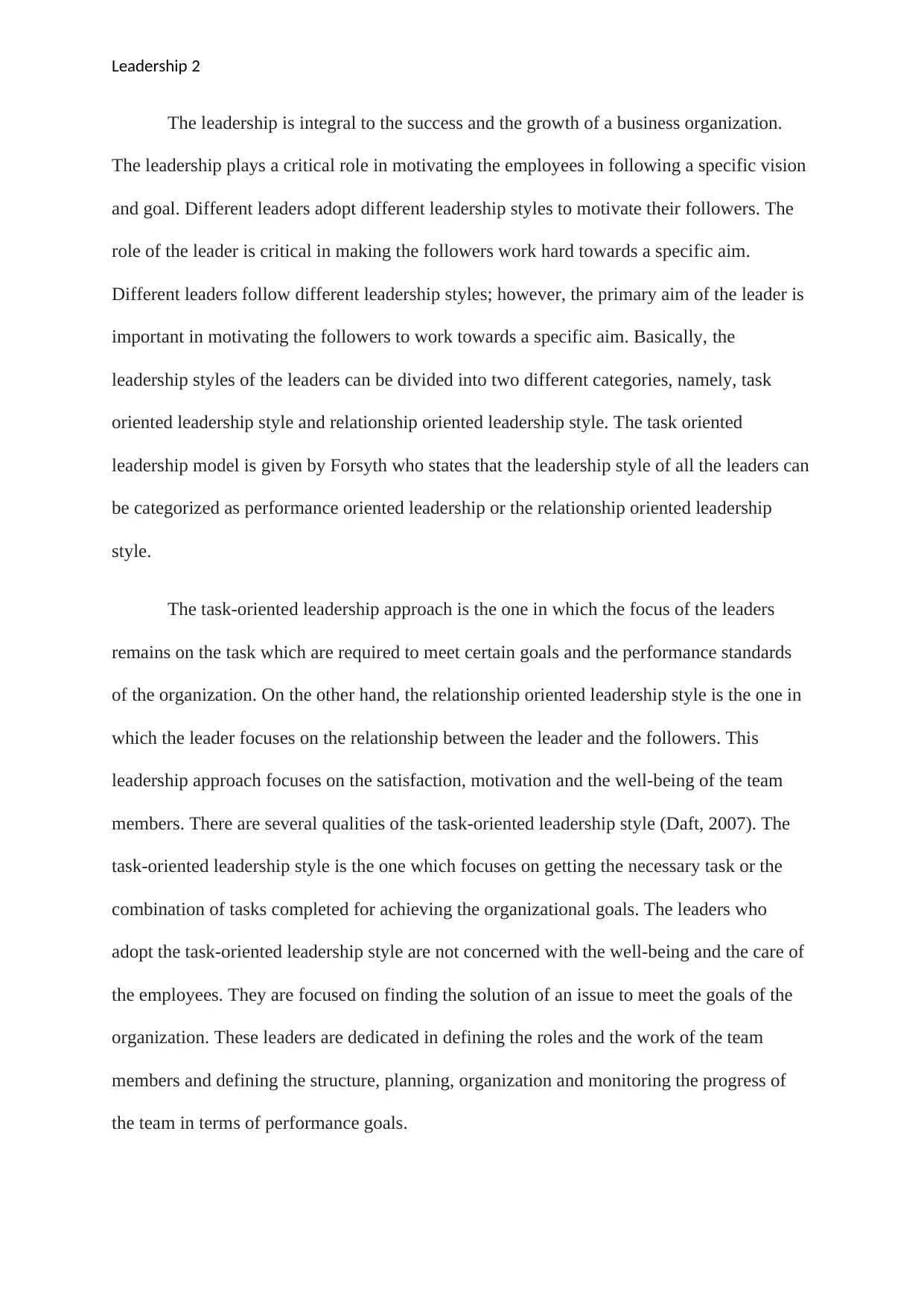
Leadership 2
The leadership is integral to the success and the growth of a business organization.
The leadership plays a critical role in motivating the employees in following a specific vision
and goal. Different leaders adopt different leadership styles to motivate their followers. The
role of the leader is critical in making the followers work hard towards a specific aim.
Different leaders follow different leadership styles; however, the primary aim of the leader is
important in motivating the followers to work towards a specific aim. Basically, the
leadership styles of the leaders can be divided into two different categories, namely, task
oriented leadership style and relationship oriented leadership style. The task oriented
leadership model is given by Forsyth who states that the leadership style of all the leaders can
be categorized as performance oriented leadership or the relationship oriented leadership
style.
The task-oriented leadership approach is the one in which the focus of the leaders
remains on the task which are required to meet certain goals and the performance standards
of the organization. On the other hand, the relationship oriented leadership style is the one in
which the leader focuses on the relationship between the leader and the followers. This
leadership approach focuses on the satisfaction, motivation and the well-being of the team
members. There are several qualities of the task-oriented leadership style (Daft, 2007). The
task-oriented leadership style is the one which focuses on getting the necessary task or the
combination of tasks completed for achieving the organizational goals. The leaders who
adopt the task-oriented leadership style are not concerned with the well-being and the care of
the employees. They are focused on finding the solution of an issue to meet the goals of the
organization. These leaders are dedicated in defining the roles and the work of the team
members and defining the structure, planning, organization and monitoring the progress of
the team in terms of performance goals.
The leadership is integral to the success and the growth of a business organization.
The leadership plays a critical role in motivating the employees in following a specific vision
and goal. Different leaders adopt different leadership styles to motivate their followers. The
role of the leader is critical in making the followers work hard towards a specific aim.
Different leaders follow different leadership styles; however, the primary aim of the leader is
important in motivating the followers to work towards a specific aim. Basically, the
leadership styles of the leaders can be divided into two different categories, namely, task
oriented leadership style and relationship oriented leadership style. The task oriented
leadership model is given by Forsyth who states that the leadership style of all the leaders can
be categorized as performance oriented leadership or the relationship oriented leadership
style.
The task-oriented leadership approach is the one in which the focus of the leaders
remains on the task which are required to meet certain goals and the performance standards
of the organization. On the other hand, the relationship oriented leadership style is the one in
which the leader focuses on the relationship between the leader and the followers. This
leadership approach focuses on the satisfaction, motivation and the well-being of the team
members. There are several qualities of the task-oriented leadership style (Daft, 2007). The
task-oriented leadership style is the one which focuses on getting the necessary task or the
combination of tasks completed for achieving the organizational goals. The leaders who
adopt the task-oriented leadership style are not concerned with the well-being and the care of
the employees. They are focused on finding the solution of an issue to meet the goals of the
organization. These leaders are dedicated in defining the roles and the work of the team
members and defining the structure, planning, organization and monitoring the progress of
the team in terms of performance goals.
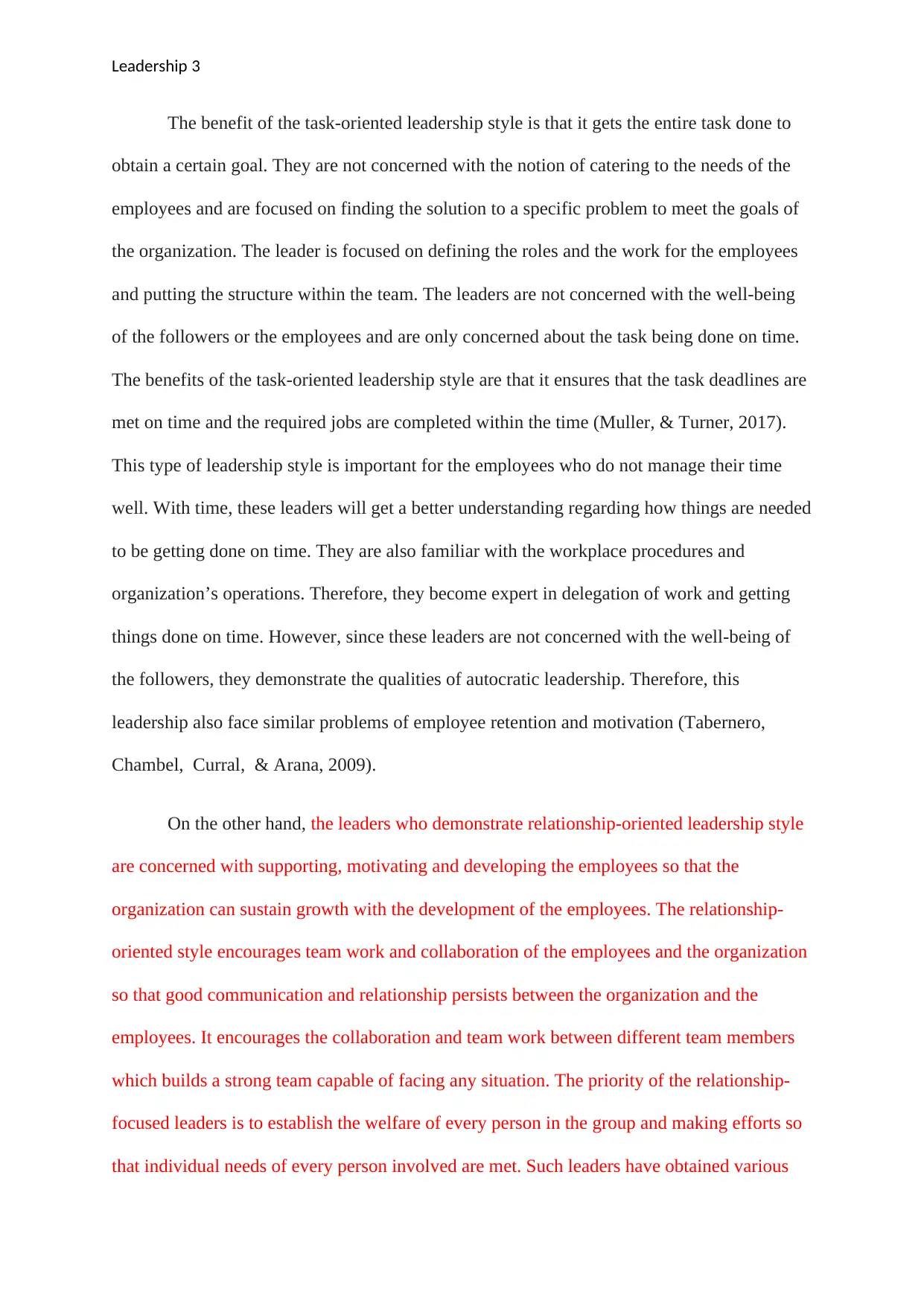
Leadership 3
The benefit of the task-oriented leadership style is that it gets the entire task done to
obtain a certain goal. They are not concerned with the notion of catering to the needs of the
employees and are focused on finding the solution to a specific problem to meet the goals of
the organization. The leader is focused on defining the roles and the work for the employees
and putting the structure within the team. The leaders are not concerned with the well-being
of the followers or the employees and are only concerned about the task being done on time.
The benefits of the task-oriented leadership style are that it ensures that the task deadlines are
met on time and the required jobs are completed within the time (Muller, & Turner, 2017).
This type of leadership style is important for the employees who do not manage their time
well. With time, these leaders will get a better understanding regarding how things are needed
to be getting done on time. They are also familiar with the workplace procedures and
organization’s operations. Therefore, they become expert in delegation of work and getting
things done on time. However, since these leaders are not concerned with the well-being of
the followers, they demonstrate the qualities of autocratic leadership. Therefore, this
leadership also face similar problems of employee retention and motivation (Tabernero,
Chambel, Curral, & Arana, 2009).
On the other hand, the leaders who demonstrate relationship-oriented leadership style
are concerned with supporting, motivating and developing the employees so that the
organization can sustain growth with the development of the employees. The relationship-
oriented style encourages team work and collaboration of the employees and the organization
so that good communication and relationship persists between the organization and the
employees. It encourages the collaboration and team work between different team members
which builds a strong team capable of facing any situation. The priority of the relationship-
focused leaders is to establish the welfare of every person in the group and making efforts so
that individual needs of every person involved are met. Such leaders have obtained various
The benefit of the task-oriented leadership style is that it gets the entire task done to
obtain a certain goal. They are not concerned with the notion of catering to the needs of the
employees and are focused on finding the solution to a specific problem to meet the goals of
the organization. The leader is focused on defining the roles and the work for the employees
and putting the structure within the team. The leaders are not concerned with the well-being
of the followers or the employees and are only concerned about the task being done on time.
The benefits of the task-oriented leadership style are that it ensures that the task deadlines are
met on time and the required jobs are completed within the time (Muller, & Turner, 2017).
This type of leadership style is important for the employees who do not manage their time
well. With time, these leaders will get a better understanding regarding how things are needed
to be getting done on time. They are also familiar with the workplace procedures and
organization’s operations. Therefore, they become expert in delegation of work and getting
things done on time. However, since these leaders are not concerned with the well-being of
the followers, they demonstrate the qualities of autocratic leadership. Therefore, this
leadership also face similar problems of employee retention and motivation (Tabernero,
Chambel, Curral, & Arana, 2009).
On the other hand, the leaders who demonstrate relationship-oriented leadership style
are concerned with supporting, motivating and developing the employees so that the
organization can sustain growth with the development of the employees. The relationship-
oriented style encourages team work and collaboration of the employees and the organization
so that good communication and relationship persists between the organization and the
employees. It encourages the collaboration and team work between different team members
which builds a strong team capable of facing any situation. The priority of the relationship-
focused leaders is to establish the welfare of every person in the group and making efforts so
that individual needs of every person involved are met. Such leaders have obtained various
⊘ This is a preview!⊘
Do you want full access?
Subscribe today to unlock all pages.

Trusted by 1+ million students worldwide
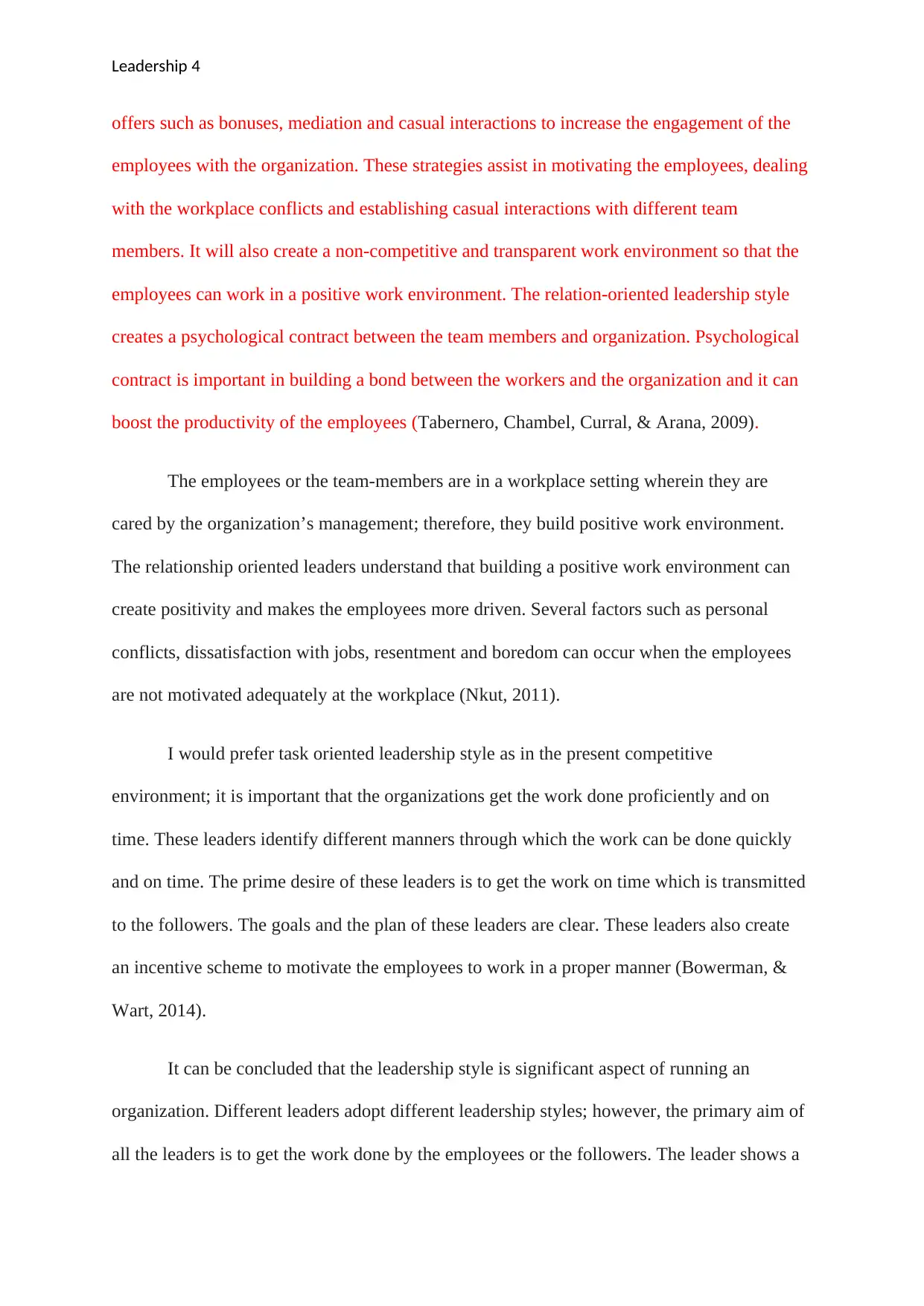
Leadership 4
offers such as bonuses, mediation and casual interactions to increase the engagement of the
employees with the organization. These strategies assist in motivating the employees, dealing
with the workplace conflicts and establishing casual interactions with different team
members. It will also create a non-competitive and transparent work environment so that the
employees can work in a positive work environment. The relation-oriented leadership style
creates a psychological contract between the team members and organization. Psychological
contract is important in building a bond between the workers and the organization and it can
boost the productivity of the employees (Tabernero, Chambel, Curral, & Arana, 2009).
The employees or the team-members are in a workplace setting wherein they are
cared by the organization’s management; therefore, they build positive work environment.
The relationship oriented leaders understand that building a positive work environment can
create positivity and makes the employees more driven. Several factors such as personal
conflicts, dissatisfaction with jobs, resentment and boredom can occur when the employees
are not motivated adequately at the workplace (Nkut, 2011).
I would prefer task oriented leadership style as in the present competitive
environment; it is important that the organizations get the work done proficiently and on
time. These leaders identify different manners through which the work can be done quickly
and on time. The prime desire of these leaders is to get the work on time which is transmitted
to the followers. The goals and the plan of these leaders are clear. These leaders also create
an incentive scheme to motivate the employees to work in a proper manner (Bowerman, &
Wart, 2014).
It can be concluded that the leadership style is significant aspect of running an
organization. Different leaders adopt different leadership styles; however, the primary aim of
all the leaders is to get the work done by the employees or the followers. The leader shows a
offers such as bonuses, mediation and casual interactions to increase the engagement of the
employees with the organization. These strategies assist in motivating the employees, dealing
with the workplace conflicts and establishing casual interactions with different team
members. It will also create a non-competitive and transparent work environment so that the
employees can work in a positive work environment. The relation-oriented leadership style
creates a psychological contract between the team members and organization. Psychological
contract is important in building a bond between the workers and the organization and it can
boost the productivity of the employees (Tabernero, Chambel, Curral, & Arana, 2009).
The employees or the team-members are in a workplace setting wherein they are
cared by the organization’s management; therefore, they build positive work environment.
The relationship oriented leaders understand that building a positive work environment can
create positivity and makes the employees more driven. Several factors such as personal
conflicts, dissatisfaction with jobs, resentment and boredom can occur when the employees
are not motivated adequately at the workplace (Nkut, 2011).
I would prefer task oriented leadership style as in the present competitive
environment; it is important that the organizations get the work done proficiently and on
time. These leaders identify different manners through which the work can be done quickly
and on time. The prime desire of these leaders is to get the work on time which is transmitted
to the followers. The goals and the plan of these leaders are clear. These leaders also create
an incentive scheme to motivate the employees to work in a proper manner (Bowerman, &
Wart, 2014).
It can be concluded that the leadership style is significant aspect of running an
organization. Different leaders adopt different leadership styles; however, the primary aim of
all the leaders is to get the work done by the employees or the followers. The leader shows a
Paraphrase This Document
Need a fresh take? Get an instant paraphrase of this document with our AI Paraphraser
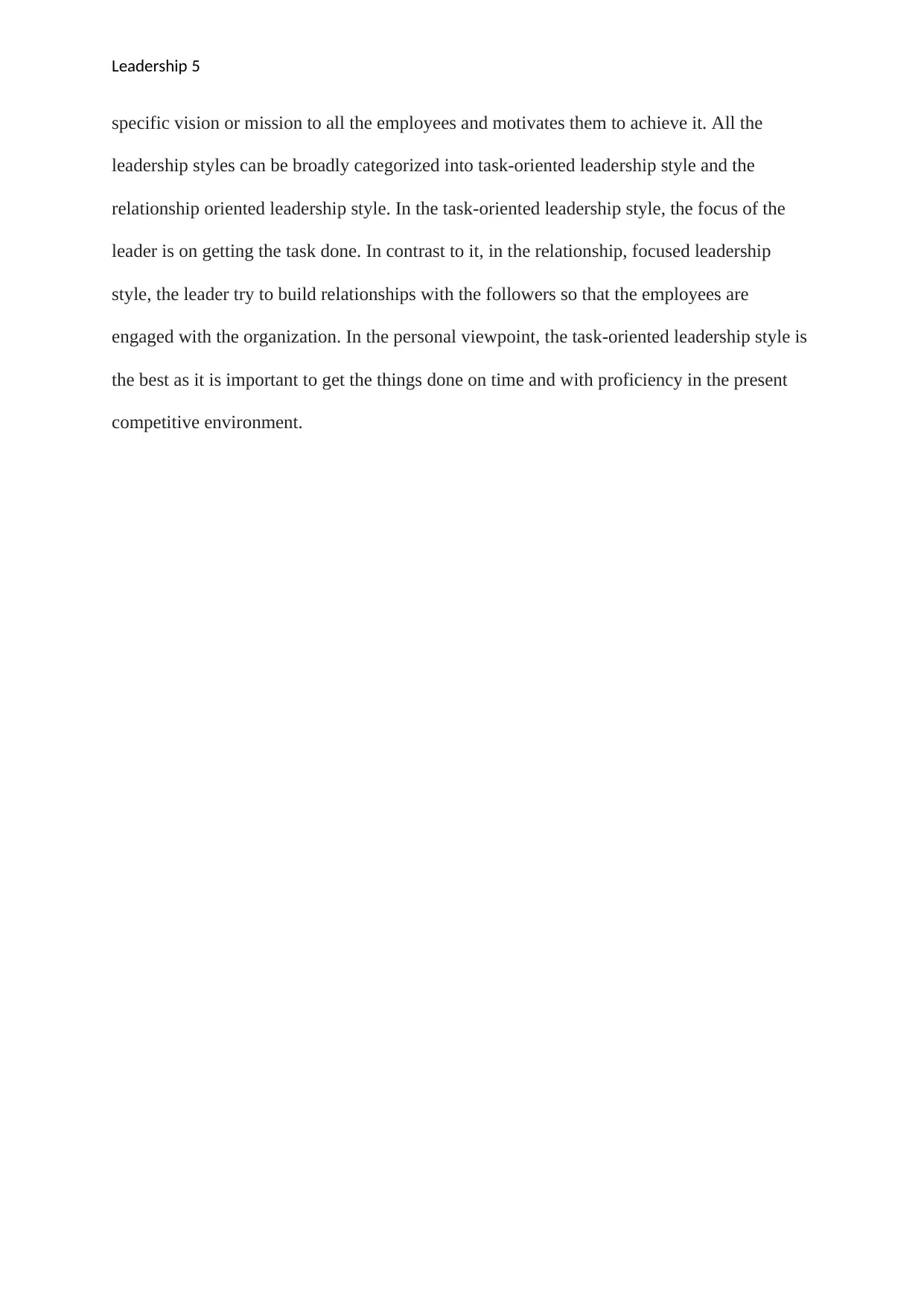
Leadership 5
specific vision or mission to all the employees and motivates them to achieve it. All the
leadership styles can be broadly categorized into task-oriented leadership style and the
relationship oriented leadership style. In the task-oriented leadership style, the focus of the
leader is on getting the task done. In contrast to it, in the relationship, focused leadership
style, the leader try to build relationships with the followers so that the employees are
engaged with the organization. In the personal viewpoint, the task-oriented leadership style is
the best as it is important to get the things done on time and with proficiency in the present
competitive environment.
specific vision or mission to all the employees and motivates them to achieve it. All the
leadership styles can be broadly categorized into task-oriented leadership style and the
relationship oriented leadership style. In the task-oriented leadership style, the focus of the
leader is on getting the task done. In contrast to it, in the relationship, focused leadership
style, the leader try to build relationships with the followers so that the employees are
engaged with the organization. In the personal viewpoint, the task-oriented leadership style is
the best as it is important to get the things done on time and with proficiency in the present
competitive environment.
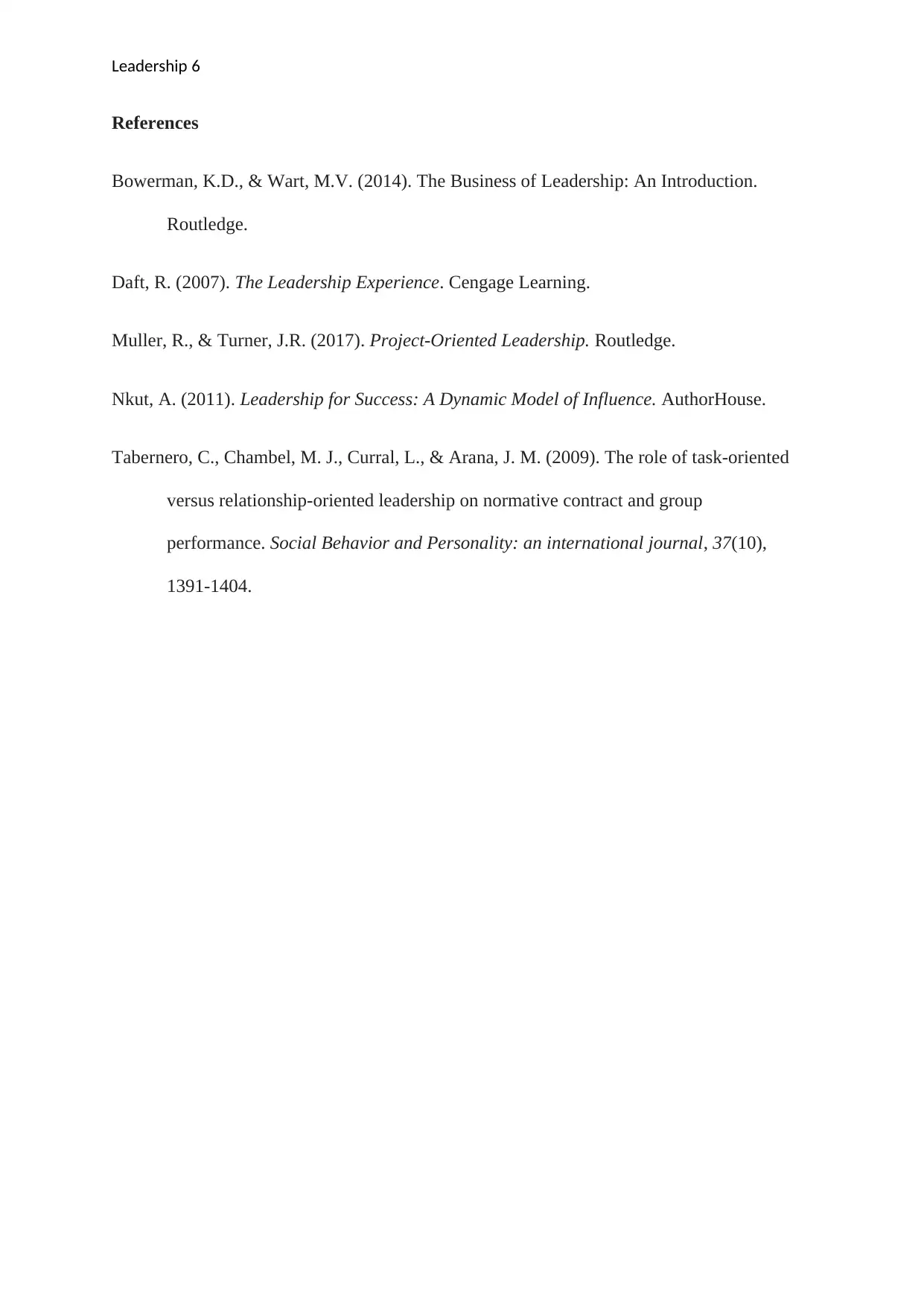
Leadership 6
References
Bowerman, K.D., & Wart, M.V. (2014). The Business of Leadership: An Introduction.
Routledge.
Daft, R. (2007). The Leadership Experience. Cengage Learning.
Muller, R., & Turner, J.R. (2017). Project-Oriented Leadership. Routledge.
Nkut, A. (2011). Leadership for Success: A Dynamic Model of Influence. AuthorHouse.
Tabernero, C., Chambel, M. J., Curral, L., & Arana, J. M. (2009). The role of task-oriented
versus relationship-oriented leadership on normative contract and group
performance. Social Behavior and Personality: an international journal, 37(10),
1391-1404.
References
Bowerman, K.D., & Wart, M.V. (2014). The Business of Leadership: An Introduction.
Routledge.
Daft, R. (2007). The Leadership Experience. Cengage Learning.
Muller, R., & Turner, J.R. (2017). Project-Oriented Leadership. Routledge.
Nkut, A. (2011). Leadership for Success: A Dynamic Model of Influence. AuthorHouse.
Tabernero, C., Chambel, M. J., Curral, L., & Arana, J. M. (2009). The role of task-oriented
versus relationship-oriented leadership on normative contract and group
performance. Social Behavior and Personality: an international journal, 37(10),
1391-1404.
⊘ This is a preview!⊘
Do you want full access?
Subscribe today to unlock all pages.

Trusted by 1+ million students worldwide
1 out of 6
Related Documents
Your All-in-One AI-Powered Toolkit for Academic Success.
+13062052269
info@desklib.com
Available 24*7 on WhatsApp / Email
![[object Object]](/_next/static/media/star-bottom.7253800d.svg)
Unlock your academic potential
Copyright © 2020–2025 A2Z Services. All Rights Reserved. Developed and managed by ZUCOL.





